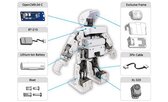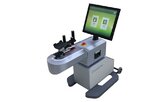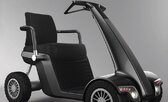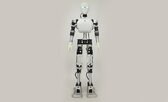Medical Rehabilitation 

Artificial Joint Surgery Robot
- * Model No. :ROBODOC® Encore Surgical System
- * Use of Product :knee and Hip artificial Joint Replacement(TKA, THA)
- * Size : 77.8cm(W)× 125.7cm(D)× 195.5~233.6cm(H)
- * Weight :359kg
- * Sales Site : http://www.curexo.com

Product Features
A compound word "ROBODOC" is
formed from the words "Robot" and "Doctor". This name has
been created to stand for a robot doctor, which provides the most advanced
medical technologies and services. ROBODOC performs orthopedic surgeries such
as Total Knee Arthroplasty and Total Hip Arthroplasty. ROBODOC System has been
composed with ORTHODOC, a pro-surgical planning workstation, and ROBODOC, which
provides the precise preparation of the bone with its robot arm.
Procedures
of the Robot surgery
-
Examination of the affected joint through a CT scan
After deciding to undergo ROBODOC surgery,
the doctor carries out a CT scan of the hip, knee and ankle joints to determine
the mechanical axis of the limb, and to build a three-dimensional model of the
affected area where ‘virtual surgery’ is designed.
-
Pre-surgical plan
The 3D model is subsequently scrutinized by
the doctors to facilitate the proper planning and execution of the surgery.
Since the final plan is exclusively for one patient, an artificial joint is
created for the benefit of the same patient. Said artificial joint is patterned
to the natural joint through milling and cutting by the robot; thus, matches
the right shape and minimizing bone loss. Stating otherwise, a virtual surgery
is also carried out to ensure the successful outcome of the actual surgery.
-
The robot executes the doctor’s order according to the pre-planning
During the actual surgery, ROBODOC works
according to the doctor’s design to ensure high levels of precision in the
cutting of the bone. The bone is milled to the accuracy of sub millimeter which
cannot be done by human beings. The high technology mechanism adopted by
ROBODOC has a stable surgery results thereby eliminating human error.Advantages
of ROBODOC
-
The surgery plan is exclusively for ONE patient
Just as every individual have
different facial features, each and everyone has a unique bone structures.
Using a 3D model, the doctor drafts a surgery plan solely for the specific
patient.
-
Accuracy of artificial joint
There is an extensive preparation in
selecting and the insertion of an artificial joint to the specific
patient. The doctor uses the ROBODOC to
create new joints that exactly matches the damaged or worn out human joints and
inserts it accurately to the human body.
-
Approved by the US FDA, confirmed by Korea Regulation.
ROBODOC
Surgery is the artificial joint replacement using high tech robotic equipment
which is approved in accordance to Korea’s safety standards in medical
practice. -
Minimize the probability of a revision surgery
ROBODOC
surgery is a specific operation to each patient. Through accurate planning to
achieve ideal surgery results, the life of the artificial joint is lengthened
with minimal risks and complications. -
Precise bone cutting
ROBODOC surgery uses an accurate
planning and has the precise cutting mechanism ability to minimize unnecessary
bone loss and human error.
-
Better results
ROBODOC surgery has better results
than manual surgery. It prevents the imbalanced length to legs,
thromboembolism, and fractures. More so, with ROBODOC surgery there are lesser
tools used than in a manual surgery which can lead to exposure with different
infections.
Differences
between ROBODOC surgery and Traditional(General or Manual) surgery
In the case of traditional surgery, surgeon
determines the type, size, and location of prosthesis based on 2D radiographs,
and performs the surgery according to the experience.
However, in the case of ROBODOC surgery,
ORTHODOC converts the CT scan of the patients joint into a 3D bone image, which
allows surgeons to establish a precise preoperational planning. This enables
surgeon to perform a virtual surgery based on the patient CT data, Using
controlled, gentle pressure the ROBODOC can mill the bone with sub-millimeter
accuracy as specified by the preoperative plan.
The length of hospitalization depends on
the condition of the patients, but usually, the post-operative hospitalization
period is shorter in ROBODOC surgery (e.g. L Hospital in Korea; average
hospitalization period is 5 to 7 days only.)
Product Videos
Kneepan and hipbone artificial joint surgery (TKA, THA)
Organization Informaion
| Company Name | GERI | Department | |
|---|---|---|---|
| Contact | |||
| Tel | Fax | ||
| Service Hours | Site | http://www.curexo.com |
About 12 results
- Department : Global Expansion Team
- Contact : Yangji Regina Kwon
- Tel :
Did you meet on this information?








 LINE-Core m (Humanoid),LSM-micro (Servo motor)
LINE-Core m (Humanoid),LSM-micro (Servo motor) UARO CODING ROBOT
UARO CODING ROBOT Rokit Smart
Rokit Smart KSS-1500 (SCARA Robot)
KSS-1500 (SCARA Robot) 5720T-A03
5720T-A03 RQ-HUNO
RQ-HUNO RQ+KIT Series
RQ+KIT Series BIMOS
BIMOS UXA-90 - LIGHT
UXA-90 - LIGHT ROBOSEM
ROBOSEM DYNAMIXEL PRO
DYNAMIXEL PRO DARWIN MINI
DARWIN MINI Paper Pot Production System
Paper Pot Production System VANDI
VANDI Cracked Egg Selector
Cracked Egg Selector Plant Growth Management Robot System
Plant Growth Management Robot System Insect Control Robot for Controlled Agriculture
Insect Control Robot for Controlled Agriculture Calf Nutrition Management Robot System
Calf Nutrition Management Robot System Pot Flower Transplant Robot
Pot Flower Transplant Robot A Smart Robot System for separate loading of agricultural products
A Smart Robot System for separate loading of agricultural products Crop Growing Monitoring Octocopter Robot
Crop Growing Monitoring Octocopter Robot MAXX Series
MAXX Series MAXX Series
MAXX Series MAXX Series
MAXX Series MAXX Series
MAXX Series MAXX Series
MAXX Series Trunk Stability Robot Balance Trainer
Trunk Stability Robot Balance Trainer HEXAR-KR40P
HEXAR-KR40P Artificial Joint Surgery Robot
Artificial Joint Surgery Robot Silvert
Silvert Hospital delivery robot for medical samples
Hospital delivery robot for medical samples Middle Aperture Image Diagnosis Robot
Middle Aperture Image Diagnosis Robot Small Aperture Image Diagnosis Robot
Small Aperture Image Diagnosis Robot Internal Diagnosis System with No Water Supply Cut Off
Internal Diagnosis System with No Water Supply Cut Off Upper Limb Rehabilitation Robot
Upper Limb Rehabilitation Robot Explosive Ordnance Disposal Robot
Explosive Ordnance Disposal Robot Bird Alert Robot System
Bird Alert Robot System Autonomous Flight Robot
Autonomous Flight Robot Small-sized Unmanned Aerial Vehicle
Small-sized Unmanned Aerial Vehicle FURO-i
FURO-i FURo-D
FURo-D Pony Horse
Pony Horse Guide Explanation Robot
Guide Explanation Robot BB-rider classic / BB-rider handsfree
BB-rider classic / BB-rider handsfree ARO3
ARO3 6Axis robot based Body mount assembly line
6Axis robot based Body mount assembly line Bin-Picking Gantry Robot
Bin-Picking Gantry Robot Industrial Robot System
Industrial Robot System Robot Based Ultrasonic Machining System
Robot Based Ultrasonic Machining System TOP DROSS REMOVAL ROBOT SYSTEM
TOP DROSS REMOVAL ROBOT SYSTEM ROBOT TANDEM LINE
ROBOT TANDEM LINE JuniDelta-Mini
JuniDelta-Mini iJINI
iJINI SILBOT
SILBOT SAM-Series
SAM-Series Automobile and Home Appliance Part Deburring Robot System
Automobile and Home Appliance Part Deburring Robot System Nondestructive Destructive Test
Nondestructive Destructive Test Gilvert
Gilvert UXA-90
UXA-90 Long Distance Feeding Diagnostic System (SUMIRE)
Long Distance Feeding Diagnostic System (SUMIRE) Small Sized Urban Fire Protection Robot
Small Sized Urban Fire Protection Robot ARTORO
ARTORO Cloud-based Comfort/Safety Agent Robot
Cloud-based Comfort/Safety Agent Robot Water Rescue Robot
Water Rescue Robot ROGEATER
ROGEATER











